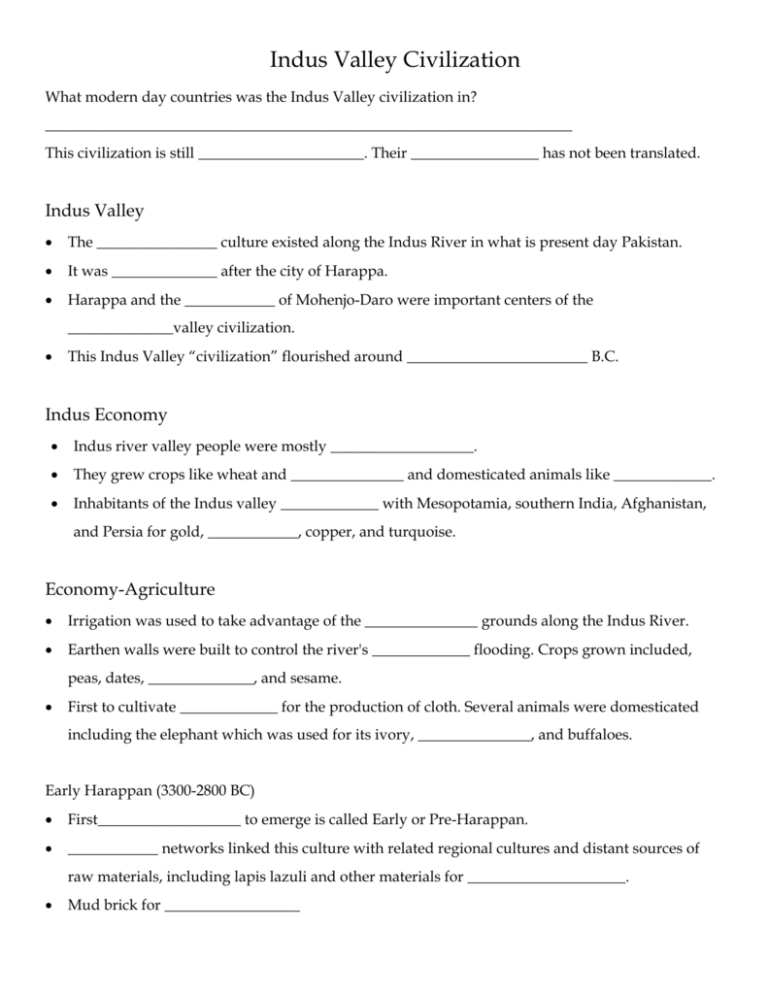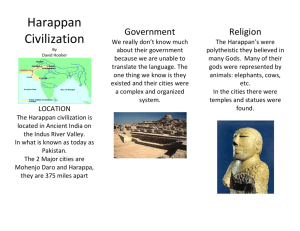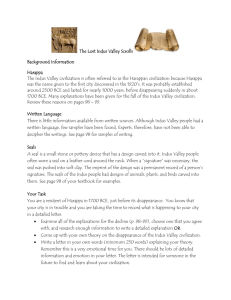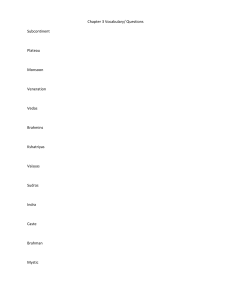The Hindu Caste System
advertisement

Indus Valley Civilization What modern day countries was the Indus Valley civilization in? ______________________________________________________________________ This civilization is still ______________________. Their _________________ has not been translated. Indus Valley The ________________ culture existed along the Indus River in what is present day Pakistan. It was ______________ after the city of Harappa. Harappa and the ____________ of Mohenjo-Daro were important centers of the ______________valley civilization. This Indus Valley “civilization” flourished around ________________________ B.C. Indus Economy Indus river valley people were mostly ___________________. They grew crops like wheat and _______________ and domesticated animals like _____________. Inhabitants of the Indus valley _____________ with Mesopotamia, southern India, Afghanistan, and Persia for gold, ____________, copper, and turquoise. Economy-Agriculture Irrigation was used to take advantage of the _______________ grounds along the Indus River. Earthen walls were built to control the river's _____________ flooding. Crops grown included, peas, dates, ______________, and sesame. First to cultivate _____________ for the production of cloth. Several animals were domesticated including the elephant which was used for its ivory, _______________, and buffaloes. Early Harappan (3300-2800 BC) First___________________ to emerge is called Early or Pre-Harappan. ____________ networks linked this culture with related regional cultures and distant sources of raw materials, including lapis lazuli and other materials for _____________________. Mud brick for __________________ Middle Harappan (2600-1900 BC) By 2500 BC, communities had been turned into _____________ centers. _________ such urban centers have been discovered. In total, over 1052 cities and __________________ have been found, mainly in the general region of the Ghaggar-Florence River and its tributaries. ___________________ was used to increase crop production and mud brick structures. Late Harappan (1700-1300 BC) _______________ of human remains began during this time period. The bones were stored in painted pottery burial urns. This is completely different from the earlier people where bodies were buried in wooden _______________. Reddish ________________, painted in black with antelopes, peacocks, the sun, stars, etc. _________________ became a main crop. Apparent breakdown of the widespread __________________ of the Indus civilization, with materials such as marine shells no longer used. Continued use of ________________ for building. Natural Resources The Indus Valley contained numerous _________________ resources that were an important part of Harappan civilization. Resources included: Fresh water and _______________ Materials such as ______________, silver, semi-precious stones. ________________ (ocean water) resources. Himalayan Mountains Melting ____________ from the mountains provided a continuous source of water for the Indus and its tributaries. Also provided important timber, animal products, and minerals, gold, silver, __________ and semiprecious stones that were traded. Valleys _________________ in Chitral valley is still used to make houses and coffins, following a tradition that dates back to the first Indus cities. Source of the deep _________________ lapis lazuli. Mined during the Indus period and traded throughout the Indus Valley and far off Mesopotamia and _____________. Coast Ancient Harappan sites were located along the _________ spreading to the border of modern Iran. These coastal settlements were involved in ________________ and trading, using the monsoon winds to travel back and forth to Oman and the Persian Gulf region. _____________________: Mohenjo-Daro and Harappa The cities are well known for their impressive, organized and regular layout. They have well laid our plumbing and drainage system, including indoor toilets. Over one thousand other towns and villages also existed in this region. The similarities between Mohenjo-Daro and Harappa indicate that they were part of a unified, organized government. o _____________________ of the same type and shape of bricks o May have existed simultaneously and sizes suggest they served as ______________ o __________________ were not elaborate; more simplistic and contain few goods. o Remains of palaces or _____________________ have not been found. o No evidence of _____________________ activity, though the cities did contain fortifications and artifacts such as copper and bronze knives, ___________, and arrowheads were found. The Great Bath- Earliest public ______________ tank Streets At Mohenjo-Daro narrow _______________ and alleyways are off of the major streets, leading into more private neighborhoods. Many of the brick houses were two ____________ high, with thick walls and high ceilings to keep the rooms ______________ in the hot summer months. Wells Private ______________ were rebuilt over for large households and neighborhoods. A large public well and public bathing platforms were found at _____________________ Public bathing areas may also have been used for washing ______________ as is common in many cities in Pakistan and India today. Language Used a ______________________ script Some 3500 specimens of this script ______________ in stamp seals carved in stone, in molded terracotta and amulets, in fragments of pottery, and in a few other inscribed objects. Seals and amulets often contain mostly realistic pictures of ______________apparently worshipped as _______________ and a few scenes of deities and worshippers. This material is important to the investigation of the Harappan language and ___________ The_________ of Indus writing can now be traced to the Ravi Phase (c. 3300-2800 BC) at Harappa. Harappan Astronomy Although the translation of the Harappan script is still not complete, there are numerous indications that Harappans were well versed in astronomy. The straight streets of the Indus cities are oriented towards the cardinal directions. Like other urban civilizations, it undoubtedly needed a calendar that adjusted to the lunar and solar transitions. Artifacts Egg shaped whistles may have been used for music. Clay Sculptures Pottery Copper plates Ornaments including: o -bangles, chokers, long pendant necklaces, rings, earrings, hair ornaments, and broaches. Ornaments were never buried with the dead, but were passed from one generation to the next. They were hidden under the floors in the homes of wealthy merchants or goldsmiths. Collapse of Harappan “Civilization” Eventually the Harappan Civilization collapsed and _________________________. Architectural and ceramic forms changed along with the loss of _______________, planned settlements, public sanitation, monumental architecture, _____________, seals, and weights. There are ________ theories as to how this could have happened. Intense ___________________ ________________ in precipitation Lower _______________ levels of the Sarasvati River Religions of the World Hinduism Brought to this region by a group of ______________ called Aryans Absorbed many beliefs from other ______________ Hindus believe there are many _______________to worship. They are _______________________- believe in many gods and goddesses. Still a major religion today especially in _____________ and considered to be the _____________religion still being practiced. Hindus believe that all living things have many ________________ When you die, your soul is ____________ in the body of another living thing. This is called ________________________. If you do good things in this life, you will come back wiser and _______________in your next life. The opposite is also true. Doing bad things could cause you to come back as a ________________! The Hindu Caste System- Social Structure in India Definition: A type of social organization/hierarchy in which a person’s ______________ and position in life is determined by the circumstances of his ______________. Rigid, hereditary _____________________ into birth caste ___________________ only among member of same caste Occupation _________________ restricted Personal ______________________ with other castes restricted Acceptance of fixed place in __________________ Members of a caste _____________ on each other for support Reincarnation: A ______________ is born, lives, dies, and is reborn again many times. Souls are reborn many times until they are pure enough to be with the creator, Brahma __________: A person’s social position in the next life is determined by his conduct in the present life. Dharma : Code of behavior or set of moral and ethical _____________that govern the conduct of each social class. Each group has a ____________ set of rules to live by. Laws of Manu- Hindu book of __________________ Rules and restrictions for daily ________________ Four Levels Brahmins – Priests, ______________, Judges; usually don’t own land therefore need other castes to work the land and provide for them Kshatriyas – ______________ and Rulers (landowners) Vaisyas – Skilled Traders, Merchants, _______________ Sudras – Unskilled Workers—_______________ and Craft workers Below these_________ castes are people who belong to no caste: Untouchables – Outcastes Concept of pollution…the most pure at the ____________ (Brahmins) and the most polluted at the ______________(Untouchables) Brahmins Purpose is to help people of other _______________ fulfill their dharma Perform rituals and observe ___________ for the sake of others Kshatriyas Responsible for _______________________ of the people Often rely on advice from Brahmins Vaisyas Shopkeepers who sell ____________________ (unlike the Shudra who sell services) Sudras Each subgroup of this caste performs a specific _______________. Jobs include _____________________, potters, and clothes washers Outcastes: Belong to no ____________ Expected to do the “____________” jobs Come in contact with animal skins, ____________ bodies and human feces Avoid contact with “caste” __________________ for fear of “pollution” Buddhism Based on the ____________________ of Siddhartha Gautama Called ______________ This means the “_______________________ One” He ____________________ a new way of life to end suffering. Reaching __________________ is the goal of Buddhism. This means a state of great wisdom, compassion, and being free from ______________________. Still a major religion today especially in __________________Asian countries.






![Indus[1] - ridgeaphistory](http://s3.studylib.net/store/data/006736077_1-c59280ecd30594bac8ab21ec7bce4db4-300x300.png)


